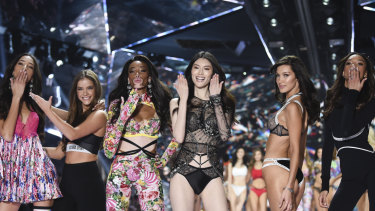
L Brands Inc., owner of the lingerie chain, announced Wednesday plans to close about 53 Victoria’s Secrets in North America this year, more than three times the 15 it’s historically closed down in an average year. Victoria’s Secret square footage in North America will drop by about 3 per cent, it said, even as it continues to grow the footprint of its more successful Bath & Body Works chain.
“Given the decline in performance at Victoria’s Secret, we have substantially pulled back on capital investment in that business versus our history,” the company said in written earnings commentary after reporting disappointing holiday-quarter results.
The rough patch isn’t new: Victoria’s Secret has been under scrutiny for years for failing to keep up with shifting consumer demands, especially involving themes of female empowerment and diversity.
But its reticence to change has been made even more pronounced with the emergence of competitors like Rihanna’s lingerie company Savage X Fenty, American Eagle Outfitters Inc.’s Aerie and ThirdLove, which aim to be more inclusive of women of different shapes, sizes and backgrounds. The road only gets harder from here: Major retailer Target Corp. announced earlier this week plans to launch three new private-label brands specializing in low-cost underwear and sleepwear.
A weak holiday quarter only heightened the need for change. Comparable sales were down 3 per cent at the retailer, dragged down by a 7 per cent decline from in-store sales. Its PINK brand, once a favorite of younger shoppers, saw a low-double digit same-store sales slide in the fourth quarter, while lingerie was flat in what’s normally a big gifting period. Across all categories, increased discounting intended to drive traffic meant margins took a major hit.
On the back of the tough quarter at Victoria’s Secret, L Brands said it sees total company profit, excluding some items, in a range of $US2.20 to $US2.60 this year. That’s well below the average estimate from analysts. Late last year, the company announced it would slash its dividend in half, a move Wall Street called surprising but prudent.
“The outlook illustrates that the lingerie-sales struggle will persist until the retailer finds a way to reconnect with shoppers on price, product and image,” Bloomberg Intelligence analysts Poonam Goyal and Morgan Tarrant wrote in a note. “Investments in VS’ e-commerce site and employees crimp margin but are vital to success.”
To try to breathe new life into the aging brand, the company has cycled through a series of leaders. Sharen Jester Turney, who led the chain for a decade, abruptly retired in 2016. Jan Singer took over later that year, exiting after about two years. John Mehas, formerly president of luxury label Tory Burch, was put in charge of Victoria’s Secret Lingerie earlier this year. It also hired a new head of the PINK brand last year.
One of Mehas’s first big moves was partnering with a French luxury label to sell high-end lingerie as its new leader looks to expand beyond discounted bras and underwear. The main focus for Mehas and PINK chief Amy Hauk will be on “getting closer to our customers and improving our merchandise assortments,” the company said, noting that it expects to see “gradual improvement” as the year progresses.
There were some bright spots: Digital was a strong suit in the latest quarter, with comparable sales online rising 8 per cent. And the company — which discontinued swimwear in 2016 — is bringing it back online in March.
“As mentioned earlier, our new CEOs in Lingerie and PINK are most focused on our product assortments, where we believe we have clear opportunities to improve,” the company said.
[“source=smh”]
